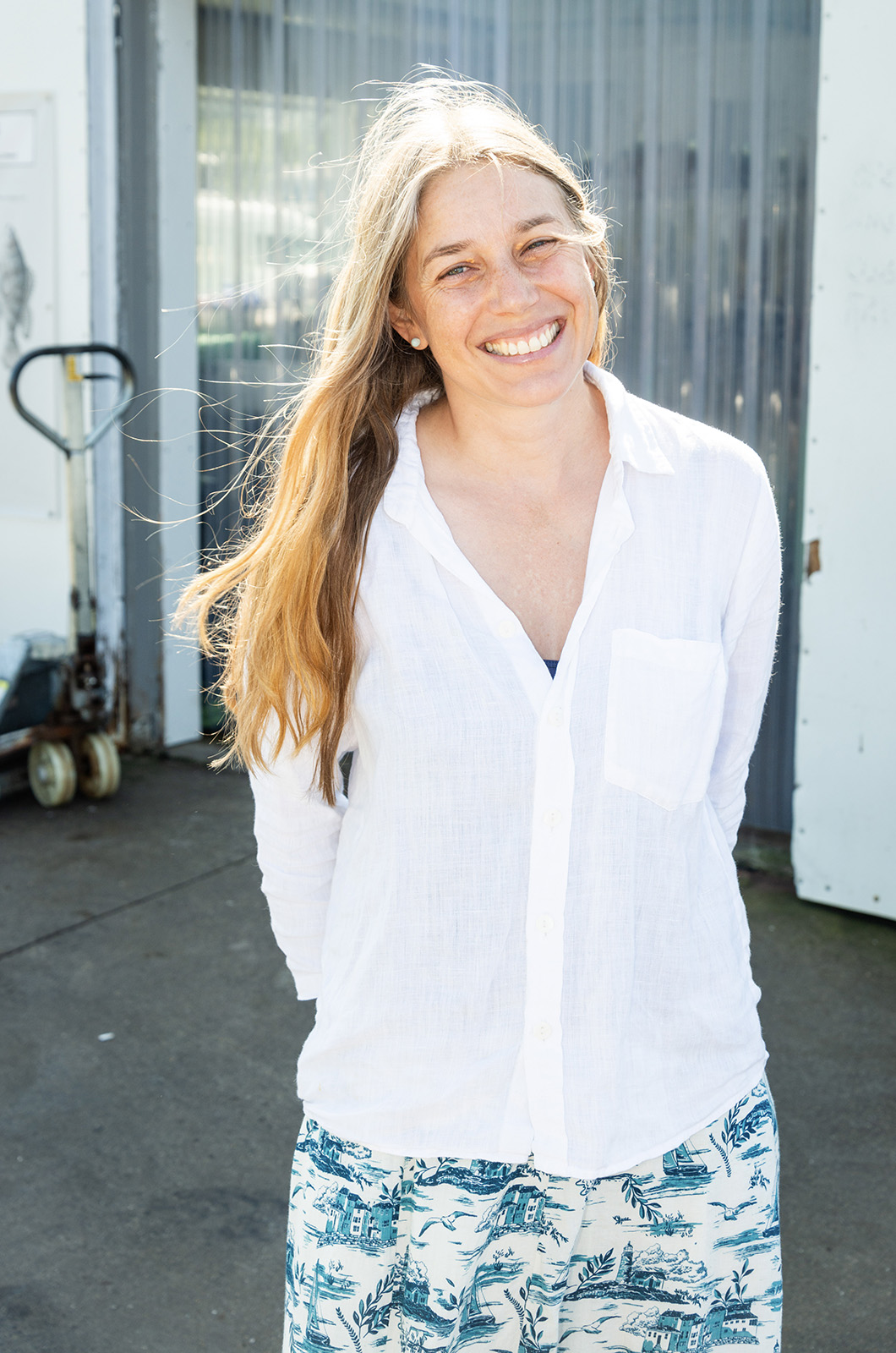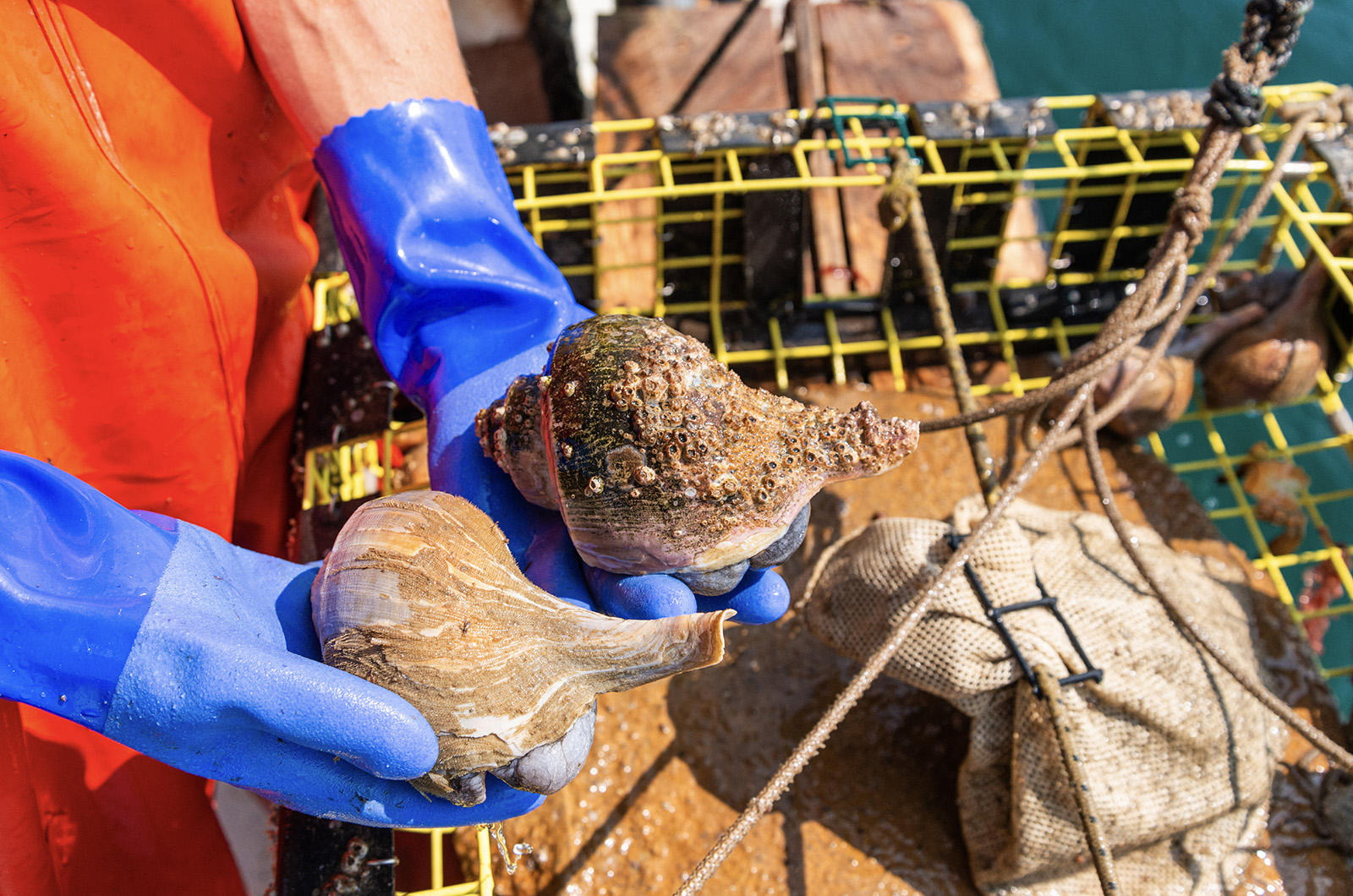Just about everything about the channeled whelk, the most lucrative catch for Vineyard commercial fishermen, is elusive.
Little is known about what whelk do between the time they hatch, emerging as 3-millimeter baby snails, to when they are caught, sometimes 40 years later. When they aren’t feeding, whelks, known on-Island as conch, bury themselves in the sea floor, confounding marine scientists hoping to study them.
Shelley Edmundson, executive director of the Martha’s Vineyard Fishermen’s Preservation Trust, knows this better than most. She earned her Ph.D. studying the species, dissecting hundreds of whelks at a New Bedford processing plant — the lingering scent of dead snails made her unpopular among other lab students — and tagging 14,000 living individuals.
By the time she completed her thesis, Ms. Edmundson remained unsatisfied.
“I went in trying to answer questions, ended up finding a million more,” she said. “They’re such a simple, slow-moving creature, yet they’ve been puzzling us for decades.”
A critical question before both researchers and commercial fishermen is what makes horseshoe crab such an appetizing bait for conch.
This summer, researchers at the University of New Hampshire (UNH) are collaborating on a study with the fishermen’s preservation trust and Island fishermen to find out what other baits could attract conch. The work has taken on a sense of urgency as state regulators tighten horseshoe crab quotas, threatening the viability of the whelk fishery.
“It’s been this mystery: what is so enticing about horseshoe crab?” Ms. Edmundson said.
In the wild, whelk are scavengers and predators, mostly feeding on shellfish. They are unable to hunt horseshoe crab, raising questions on why they are drawn to the bait.
Not only have researchers previously failed to discover the reason for the crab’s incredible allure but, more importantly to fishermen, they have yet to identify any bait that is as effective in the field. “Every fisherman I’ve worked with really doesn’t like using horseshoe crab. They hate that idea of that,” Ms. Edmundson said. “But, if you use it, you’re able to harvest what you need to make it worth going out.”
The use of horseshoe crab as bait has recently come under scrutiny, with the Massachusetts Division of Marine Fisheries (DMF) reducing the number allowed to be harvested for bait each year from 165,000 individuals in 2022 to 140,000 in 2023.
“There’s a lot of concern about harvesting horseshoe crabs, They serve an important ecological function,” said Elizabeth Fairchild, the professor at UNH who is leading the three-year study, which began in 2020.
Horseshoe crab eggs are an important food source for coastal shorebirds, while adult crabs serve as “bioturbators,” agitating seafloor sediments.

In addition to their ecological role, horseshoe crabs serve a critical purpose in the biomedical industry, their blood harvested to manufacture a bacterial testing compound for pharmaceuticals. This year, the DMF raised the biomedical harvest quota by 25,000 individuals to 200,000, though Ms. Fairchild noted that most of the crabs survive the blood-harvesting process and are released to the wild.
But a reduction in the bait harvest could put the squeeze on local fishermen, who typically purchase the crabs from wholesalers, Ms. Edmundson said. If no alternative is found, fishermen will be forced to pay higher prices.
Conch fishermen have already faced declining profits in their industry, with the wholesale price dropping to $3 a pound this year, the lowest it has been since 2017. Expensive gear meant to reduce the risk of whale entanglement has also eaten into profits, while recent poor spring harvests have meant fishermen have had to spend more time on the water to bring in a healthy catch.
At its peak in 2011, the Dukes County conch harvest brought in $1.4 million, more than half of total state profits in the fishery. In 2021, it brought in $261,704, just over a third of state profits.
“I think ultimately, one day, harvesting horseshoe crabs for bait won’t be allowed,” Ms. Edmundson said. “I think that we need to have an alternative solution for this fishery, or else it really won’t continue.”
The current study, Ms. Fairchild said, is taking a pragmatic approach to whelk research, focused on finding an effective and affordable conch bait. “In order for it to be adopted by the industry, it’s got to be at the right price point,” she said.

To help with the research, Ms. Edmundson and Ms. Fairchild brought on two academics: neurobiologist Win Watson, an expert on horseshoe crabs, as well as an alternative bait expert, animal physiologist Steve Jury. The team also brought in graduate student Mary Kate Munley, who wrote her master’s thesis on the topic.
The project was funded by a grant by the National Oceanic and Atmospheric Administration’s Saltonstall-Kennedy Program.
Before going out to the field, the group studied how captive whelk would react to baits in a laboratory setting. Ms. Munley first tried attaching accelerometers to the backs of the whelk to see if she could measure conch speed, hoping to gauge the snails’ enthusiasm for bait by how fast they headed to it. Ultimately, she settled on timelapse video as a better way to measure it.
In studying that video, researchers found one bait combination that seemed to work as well as horseshoe crab: a blended conglomeration of green crab and clam guts. Both are plentiful on-Island, and the former is invasive.
“It smells awful, absolutely terrible,” said Pierce Amyond, an intern with the fishermen’s preservation trust.
Mr. Amyond began work with the experimental bait last year, working on a project dubbed “whelk tv,” where they placed cameras above conch traps to study wild whelk’s reaction to the bait.
This summer, he is conducting field work with longtime Island conch fishermen Tom Turner, testing the bait in traps alongside horseshoe crab, Mr. Turner’s personal bait blend and another bait, propeller clam.
“Fishermen are really interested in testing propeller clams,” said Ms. Edmundson. The clams, a bivalve caught off the coast of Canada, have not been lab-tested, but are available cheaply and in large quantities.
The scent of propeller clam, said Mr. Amyond, has given Mr. Turner high hopes for the bait. “He told me ‘I’ve been fishing for 50 years, and this is the right smell for what I need,’” Mr. Amyond said.
Otto Osmers, another local concher, is working to test whether male or female horseshoe crabs are more attractive to whelk. The Trust is also piloting newly designed traps this year, meant to allow smaller whelk to escape and lower the workload for fishermen.
Ms. Edmundson hopes these new studies will help build collaboration — and momentum — among the wider conch fishing community.
“Hopefully we can take what we’ve learned, and then give it to fishermen on the Cape and say, ‘we’re finding this to be successful, do you guys want to test it out?’” she said.





Comments (5)
Comments
Comment policy »